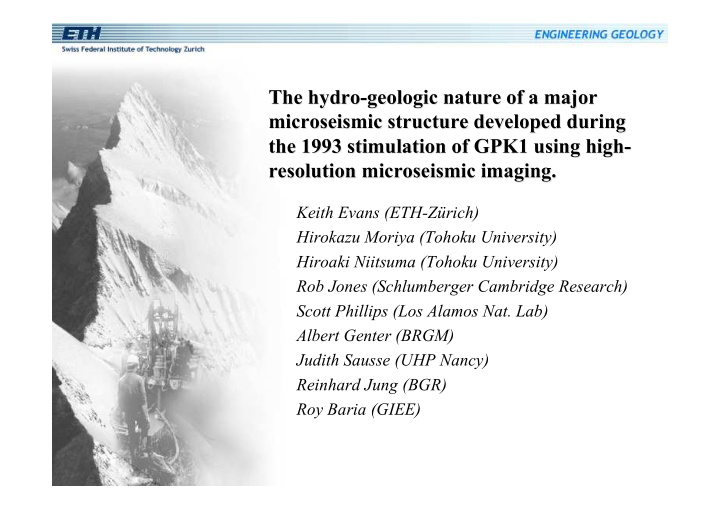



The hydro-geologic nature of a major The hydro-geologic nature of a major microseismic structure developed during structure developed during microseismic the 1993 stimulation of GPK1 using high- the 1993 stimulation of GPK1 using high- resolution microseismic microseismic imaging. imaging. resolution Keith Evans (ETH-Zürich) Hirokazu Moriya (Tohoku University) Hiroaki Niitsuma (Tohoku University) Rob Jones (Schlumberger Cambridge Research) Scott Phillips (Los Alamos Nat. Lab) Albert Genter (BRGM) Judith Sausse (UHP Nancy) Reinhard Jung (BGR) Roy Baria (GIEE)
Development of a major microseismic structure during the injection (20,000 m 3 of water) Hydraulic tests indicate these two flowing fractures, 250 m apart are linked by a low- impedance flow path within the rock mass Videos of cloud development Full cloud as imaged by JHD Full cloud after applying collapsing - numerous discrete planar or tubular structures are seen to develop…trending primarily NNW Close-up of lower structure
Evidence to suggest the structure is hydraulically-significant Note: There is a systematic difference in flow impedance of Zones 2 and 4 under injection and production conditions. -but the net impedance of these zones taken together is the same for inject and prod. (parabola because of turbulent flow) This implies the impedance is common to both zones and that they are connected by a relatively-low impedance path.
Evidence to suggest the structure is hydraulically-significant Note: There is a systematic difference in flow impedance of Zones 2 and 4 under injection and production conditions. -but the net impedance of these zones taken together is the same for inject and prod. (parabola because of turbulent flow) This implies the impedance is common to both zones and that they are connected by a relatively-low impedance path.
Dislocations of mm to cm imaged at at major flowing fractures Flow Zone 2 at top of structure : Hole split over 10 m: ~0.5 cm of largely opening-mode
Nature of the structure revealed through high-resolution microseismic images Hydraulic tests indicate these two flowing fractures, 250 m apart are linked by a low- impedance flow path within the rock mass
Multiplet-cluster E: 2975-3080 m Defines a sub-vertical structure striking NNW that has a width of meters to tens of metres Moriya et al, 2002
High-resolution image of seismicity at the base of the structure Note: View is down the structure ( Phillips, 2000) Plane 4 is aligned with and below plane defined by Multiplet-cluster E
Hydrothermally-altered, cataclastic shear structures Strike of hydrothermally- altered shear structures shear zone 3 shear zone 2 shear zone 1 after Genter et al. (2000) Note: The orientation of fractures within the shear zones tend to scatter about the orientation of the structures themselves.
Seismic moment release along structure and slip estimate Moment released in each 100 m slice is on average 1x10 11 N.m. (P-lower bound value). If this is released uniformly over 100 m along-strike width, the implied average slip on the structure is 0.3 mm, which could produce dilation that is hydraulically significant.
Conceptual model of the seismic structure (after Niitsuma) Explains: 1) Downward rather than lateral migration of flow 2) Limited size of microearthquake sources (diameters <12 m)
Conclusion. Collapsing applied to the microseismic microseismic cloud revealed a major cloud revealed a major Collapsing applied to the tubular-like structure that extended down ~300 m from a tubular-like structure that extended down ~300 m from a major flow zone to the level of another flow zone. major flow zone to the level of another flow zone. High-resolution imaging of the structure shows it is a sub- High-resolution imaging of the structure shows it is a sub- vertical, planar structure that strikes NNW. vertical, planar structure that strikes NNW. The microseismicity microseismicity is the expression of shear-related, is the expression of shear-related, The stimulation processes occurring within a hydrothermally- hydrothermally- stimulation processes occurring within a altered cataclastic, shear-zone. , shear-zone. altered cataclastic Moment release averaged over the structure yields a mean Moment release averaged over the structure yields a mean seismic slip of 0.3 mm. Slip would be greater if the moment seismic slip of 0.3 mm. Slip would be greater if the moment is released on patches (net area less than total area). is released on patches (net area less than total area).
Recommend
More recommend